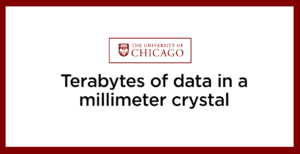Scientists Store Terabytes of Data in a Crystal the Size of a Millimeter
Researchers at the University of Chicago have developed a method to store terabytes of data in a crystal just a millimeter in size, using atomic defects to represent binary ones and zeros. By integrating rare-earth elements and optical techniques, they can manipulate these defects for efficient data storage. This breakthrough could revolutionize memory devices, enabling higher storage capacities in smaller, more compact forms.

Scientists Store Terabytes of Data in a Crystal the Size of a Millimeter
Researchers at the University of Chicago have developed a groundbreaking method to store data in a crystal by using atomic-sized defects. This technique, which marks a significant advancement in data storage, enables the creation of memory devices capable of holding terabytes of data within a cube just a millimeter in size. This innovative approach merges quantum techniques with traditional memory storage, offering a new way to improve classical, non-quantum computer memory systems.
The study, published in Nanophotonics, introduces a new type of memory storage that uses individual atomic defects within a crystal. These defects are essentially missing atoms in the crystal structure, which can be manipulated to represent binary ones and zeros. In this context, a “one” is represented by a defect that traps an electron, and a “zero” is a defect that doesn’t hold an electron. By controlling these defects, the researchers have been able to create an incredibly dense memory storage system.
This research builds on work that began with radiation dosimeters, devices that measure and store radiation exposure. These dosimeters typically store data by capturing and holding electrons in response to radiation, and the information can later be read using optical techniques, such as shining light onto the material. The researchers at the University of Chicago adapted this principle for data storage, using optical control methods to manage the charge states in the crystal’s defects.
The team utilized rare-earth elements, specifically praseodymium ions, to enhance the properties of the crystal. Rare-earth elements are known for their ability to absorb and release energy in specific ways, making them ideal for controlling the charge states of the crystal defects. By using a simple ultraviolet laser to excite the rare-earth elements, the researchers could release electrons and trap them in specific defects in the crystal structure. This process allowed them to designate specific defects as either “one” or “zero,” enabling the storage of binary data.
The research is significant because it demonstrates a new way to create memory storage that is both highly efficient and scalable. A small, millimeter-sized crystal could theoretically hold billions of individual memory cells, each corresponding to a single bit of data. The implications for this technology are far-reaching, as it could lead to the development of memory devices with vastly improved storage capacities, while maintaining a small physical footprint.
One of the key challenges in traditional data storage systems is the physical size of the components used to represent binary data. The University of Chicago team’s method overcomes this limitation by using atomic-sized defects, which allows for an unprecedented level of data density. This innovation could potentially revolutionize fields such as cloud storage, where there is a constant need to store and manage vast amounts of data in compact forms.
This work also illustrates the potential for interdisciplinary collaboration. The team combined research from quantum physics, solid-state physics, and radiation dosimetry to develop this new memory storage technology. According to the researchers, the interface between quantum systems and classical memory devices holds great promise for future innovations in data storage. While the technology is not purely quantum, it draws inspiration from quantum principles to enhance the capabilities of classical computing systems.
In the future, this technique could be applied to a wide range of materials beyond yttrium oxide crystals, depending on the properties of the rare-earth elements added to the material. The use of rare-earth ions is particularly advantageous because of their ability to interact with light in specific ways, enabling precise control over the data storage process.
Data in a Crystal: In conclusion, this research represents a significant step forward in data storage technology. By using atomic defects in crystals, the team at the University of Chicago has shown that it is possible to store vast amounts of data in incredibly small spaces, paving the way for more efficient and powerful memory devices. This development could have a major impact on a variety of industries, from computing and telecommunications to healthcare and beyond.
Check out TimesWordle.com for all the latest news
You must be logged in to post a comment.